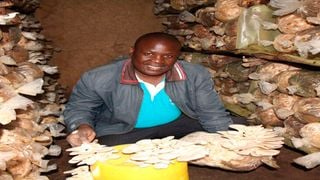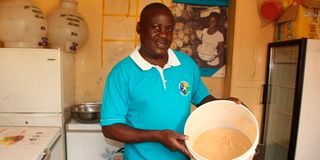
Paul Nyongesa, a former agricultural extension officer, at his mushroom farm in Kakamega County.
| Richard Maosi | Nation Media GroupSeeds of Gold
Premium
My sweet products from mushrooms
What you need to know:
- Nyongesa has not only perfected the art of growing oyster mushrooms but he also makes value-added products from the crop.
- Nyongesa started mushroom farming in 2005 and has attended various trainings over the years on growing the crop.
Situated off Webuye-Kakamega Road, Sikali is not your typical Kenyan village.
Here, most farms are dotted with sweet potatoes – the dominant crop – as many farmers ditch maize due to low prices.
“Growing sweet potatoes has picked up here as people diversify from maize,” says farmer Paul Kisiangani Nyongesa, our host. “Over the years, a 90kg bag of maize has been going for as low as Sh1,800, what has discouraged many.”
But Nyongesa does not grow the two crops, he has taken a different path, specialising in mushrooms, which he farms in mud houses on part of his one-acre homestead.
He further adds value to the harvest making a host of palatable products.
"I make fresh mushrooms, powder, soup and nutri-floor which I mix with millet, sorghum, maize and sweet potatoes," says Nyongesa, who trades under the name Galaxy Mushroom, and grows the oyster variety.
He farms the mushrooms in two mud houses measuring 5 by 7 metres. The farm also hosts collard greens, Hass avacado, pears,cherries and apple and indigenous poultry.

Paul Nyongesa dries his mushrooms in Kakamega County.
“I grow the other crops using recycled mushroom substrate that makes good organic manure. Substrate conserves plenty of moisture content and provides nutrients to plants.”
Nyongesa started mushroom farming in 2005 and has attended various trainings over the years on growing the crop, the major being one which was offered at Masinde Muliro University of Science and Technology, where he did not only learn about growing the crop but also adding value. He makes his own spawn on his farm, having studied bio-technology at Egerton University.
“I also make the substrate, which is the mushroom growing media, from sugarcane bagasse, maize cobs, wheat bran, molasses and lime.”
Having mastered mushroom production, Nyongesa ventured into value addition.
“I invested Sh100,000 into the value addition business with the money going on buying a posho mill, fridge and construction of two solar dryers each measuring a metre wide, three metres long and 0.5 metres from the ground with two shelves.”
He assembled the solar dryers himself, making them from wood cuttings and a high density polyethylene materials.
Once planted, mushrooms sprout after one and half months thus harvesting starts at 7-8 weeks.
"We harvest the mushroom every day, between 40-50 kilos. I dry about 20 kilos daily which give me 2kg of dry matter.”
Value added products
Before drying, the mushroom is split into tiny pieces and then placed on the dryer for a day to dry. But during the wet season, it takes up to two days for the produce to dry.
“With good drying, the mushroom should end up with a moisture content of about 10 per cent. I then place it in a water resistant air tight bag for grinding and storage," says Nyongesa, who has employed five youths and works with 100 farmers, from which he buys a kilo of mushrooms at Sh1,000.
Adding value to the produce, he says, has saved him from losses and waste that would arise when he failed to find market for the fresh produce.
“I sell a 50g pack of dry mushroom at Sh150. On the other hand, freshly packed 250g product goes from Sh100 to Sh150 depending on demand,” he says, adding his products are certified by the Kenya Bureau of Standards.
On the other hand, the nutri-flour that he makes from mushrooms, millet, sorghum or maize and sweet potatoes goes at Sh150 a kilo.
“I sell to households in the neighbourhood as well as groceries and supermarkets in Kakamega, Nakuru, Eldoret, Malindi and Nairobi,” he says, adding individual customers come through referrals and he also markets the products on social media such as Facebook and at agricultural field days.
Nyongesa says to succeed in such a business, there is need for consistency in production to sustain the market with both the raw and value added products.

Paul Nyongesa, a former agricultural extension officer, at his mushroom farm in Kakamega County.
“One must also get it right with packaging because the product must be free of moisture. I pack my products in air tight plastic containers for a longer shelf-life, this comes with additional costs.”
Hygiene is also key in the business. The workers must put on the correct attire such as gloves and dust coats during harvesting , sorting and packaging to avoid contamination, he offers.
“The he value addition facility should be sited at a place where there is no dust.”
Mark Kiplel, an agricultural engineer from Rift Valley Institute of Science and Technology, says mushrooms can be used to make an array of products including cookies and jam.
"Oyster mushrooms are grown by most small-scale farmers because they are adaptable to a wide range of temperatures and offer higher yields.”
According to him, mushroom value addition needs specialised training to get it right.
“One should also be familiar with the types of mushrooms and the best products that can be made out of each type to make the business profitable. For instance, the good texture, flavour and nutrient content of oyster mushroom makes it a perfect blend with other foods.”





